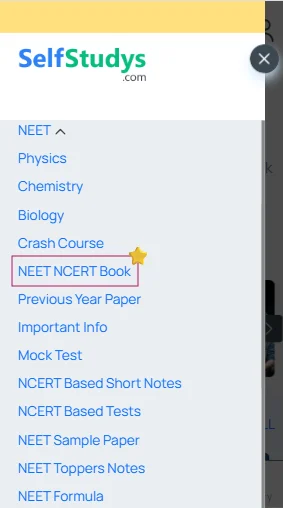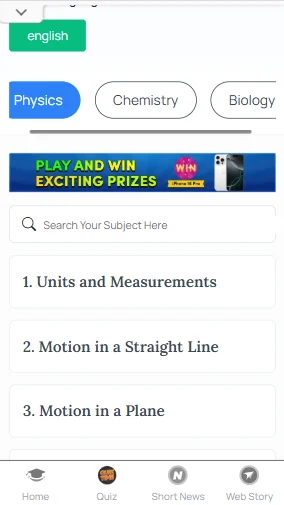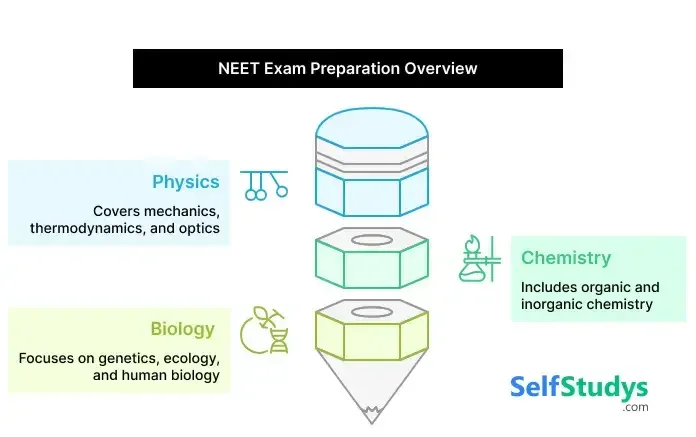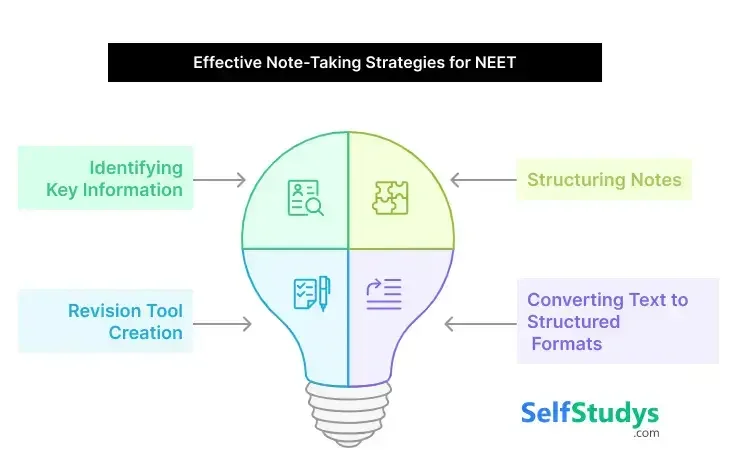- 1. Units and Measurements
- 2. Motion in a Straight Line
- 3. Motion in a Plane
- 4. Laws of Motion
- 5. Work Energy and Power
- 6. System of Particles and Rotational Motion
- 7. Gravitation
- 8. Mechanical Properties of Solids
- 9. Mechanical Properties of Fluids
- 10. Thermal Properties of Matter
- 11. Thermodynamics
- 12. Kinetic Theory
- 13. Oscillations
- 14. Waves
- 15. Electric Charges and Fields
- 16. Electrostatic Potential and Capacitance
- 17. Current Electricity
- 18. Moving Charges and Magnetism
- 19. Magnetism and Matter
- 20. Electromagnetic Induction
- 21. Alternating Current
- 22. Electromagnetic Waves
- 23. Ray Optics and Optical Instruments
- 24. Wave Optics
- 25. Dual Nature of Radiation and Matter
- 26. Atoms
- 27. Nuclei
- 28. Semiconductor Electronics - Materials Devices & Simple Circuits
- 29. Experimental Skills in Physics
One great resource that will solidify your knowledge is the NCERT books for NEET that are available for free usage at SelfStudys. They not only align with the syllabus of the exam but also form the base for most of the questions that are asked in the examination.
On our platform, we offer you free and downloadable PDFs for the NEET books NCERT. This resource will help simplify your preparation without worrying about any costs or availability. In these books, you will see the concepts in a clear, concise, and structured manner which is ideal to understand complex topics in a simple way.
NEET Exam Pattern And Role Of NCERT Books
Below is a table in which we have explained how the exam structure and best NCERT books for NEET blend with each other.
| COMPONENT | EXAM DETAILS | ROLE OF NCERT BOOKS |
|---|---|---|
|
Exam Mode |
Offline- pen and paper-based test. |
With the help of NCERT books for NEET PDF, you can develop strong fundamental concepts that are ideal for MCQs. |
|
Subjects Covered |
Physics, Chemistry, Biology |
All these three subjects are covered thoroughly in the NCERT books for NEET preparation. |
|
Number of Questions |
180 questions |
Mostly around 70 to 80% of the questions are based on the NCERT books for NEET exam. |
|
Question Type |
Multiple-Choice Questions |
In the NCERT books for NEET PDF download, examples and solved exercises are included which form the basis of many direct and conceptual MCQs. |
|
Marking Scheme |
+4 for correct answer, -1 for incorrect answer. |
By studying the NCERT books for NEET in detail, you can avoid any common misconceptions that will lead to negative markings. |
|
Total Marks |
720 marks |
Having a strong grasp of the NEET books NCERT will help you target 600+ along with consistent revision. |
|
Syllabus Basis |
Based on the curriculum of classes 11 and 12 NCERT. |
The best NCERT books for NEET are the source material for the official syllabus of the exam. |
|
Difficulty Level |
Moderate to high, varies across subjects. |
The NCERT books for NEET PDF build the foundation for the exam. So, it is necessary that you study them before using the advanced materials. |
Best NCERT Books For NEET Of Each Subject
At SelfStudys, you can explore the NCERT books for NEET preparation for every subject (Physics, Chemistry, Biology). These are the official textbooks for classes 11 and 12 with which you can master all the important topics. All these books are provided in a PDF format which you read online or download for offline use. You can also access any of the subject’s books with the help of the links mentioned below.
| Sr No | NCERT Books For NEET Subject Wise |
|---|---|
| 1 | Physics NCERT Books for NEET |
| 2 | Chemistry NCERT Books for NEET |
| 3 | Biology NCERT Books for NEET |
How To Access The SelfStudys’ NCERT Books For NEET PDF?
If you wish to get your hands on our collection of NCERT books for NEET exam and study them, have a look at the steps given below and follow them.
- Reach the main page of our digital platform with a simple prompt- www.selfstudys.com.

- You will easily find a ‘Navigation’ bar there and you need to click on it first.
- This click will let you access our main menu from where you should select the ‘NEET’ section.

- Under the NEET section, various materials will be available wherein you have to click on the ‘NEET NCERT Book’ option.

- Soon, you will get a new web page displayed on your screen that has the subjects related to NCERT books for NEET PDF download.

- After you have selected the subject, all the chapters in the NCERT books for NEET will be visible on the page.
- You can choose any chapter from the NEET books NCERT that you wish to study during preparation time.
- Finally, the PDF for your selected best NCERT books for NEET chapter can be studied or downloaded by you.
Note: In order to complete the downloading process of the NCERT books for NEET PDF, do a Google Log In or Sign up on SelfStudys.
Chapters Included In The NCERT Books For NEET Preparation
The NCERT books for NEET preparation are from both classes 11 and 12. In the table given below, we have mentioned all the chapters and topics across each subject and class along with their weightage to enhance your exam preparation.

|
CLASS 11 NCERT BOOKS |
|||
|
SUBJECT |
CHAPTER |
KEY TOPICS |
WEIGHTAGE |
|
Physics |
Physical World and Measurement |
Units, dimensions, significant figures |
2% |
|
Kinematics |
Motion in a straight line, projectile motion |
3% |
|
|
Laws of Motion |
Newton’s laws, friction, circular motion |
3% |
|
|
Work, Energy, and Power |
Work energy theorem, power, conservation of energy |
4% |
|
|
Motion of System of Particles and Rigid Body |
Centre of mass, rotational motion, moment of inertia |
5% |
|
|
Gravitation |
The universal law of gravitation, Kepler’s laws, satellite motion |
2% |
|
|
Properties of Bulk Matter |
Elasticity, stress, strain, viscosity, surface tension |
3% |
|
|
Thermodynamics |
Laws of thermodynamics, heat engines, entropy |
9% |
|
|
The behavior of Perfect Gas and Kinetic Theory |
Ideal gas laws, kinetic theory of gases |
3% |
|
|
Oscillations and Waves |
Simple harmonic motion, wave motion, Doppler effect |
3% |
|
|
Chemistry |
Some Basic Concepts of Chemistry |
Laws of chemical combination, mole concept, stoichiometry |
5% |
|
Structure of Atom |
Bohr's model, quantum numbers, atomic orbitals |
3% |
|
|
Classification of Elements and Periodicity in Properties |
Mendeleev's periodic table, periodic trends |
4% |
|
|
Chemical Bonding and Molecular Structure |
Ionic, covalent bonds, hybridization, VSEPR theory |
9% |
|
|
States of Matter: Gases and Liquids |
Gas laws, ideal gas equation, surface tension, viscosity |
4% |
|
|
Thermodynamics |
First law, enthalpy, entropy, Gibbs free energy |
3% |
|
|
Equilibrium |
Le Chatelier's principle, Kc, Kp, ionic equilibrium |
4% |
|
|
Redox Reactions |
Oxidation-reduction, balancing redox reactions |
2% |
|
|
Hydrogen |
Isotopes, hydrides, water, hydrogen peroxide |
2% |
|
|
s-Block Elements |
Alkali and alkaline earth metals, properties, uses |
3% |
|
|
Some p-Block Elements |
Group 15-18 elements, their compounds, properties |
7% |
|
|
Organic Chemistry – Some Basic Principles and Techniques |
IUPAC nomenclature, isomerism, reaction mechanisms |
5% |
|
|
Hydrocarbons |
Alkanes, alkenes, alkynes, aromatic compounds |
4% |
|
|
Environmental Chemistry |
Environmental pollution, greenhouse effect, ozone depletion |
2% |
|
|
Biology |
Diversity of Living Organisms |
Classification systems, Kingdoms, Plant and Animal Kingdoms, Botanical and zoological nomenclature |
7% |
|
Structural Organisation in Animals and Plants |
Animal tissues, Morphology, and Anatomy of flowering plants, floral formula, and diagrams |
5% |
|
|
Cell: The Unit of Life |
Cell theory, Prokaryotic and Eukaryotic cells, Cell organelles, Fluid Mosaic Model of plasma membrane |
4% |
|
|
Biomolecules |
Carbohydrates, Proteins, Nucleic acids, Enzymes |
4% |
|
|
Cell Cycle and Cell Division |
Mitosis, Meiosis, Cell cycle phases |
3% |
|
|
Transport in Plants |
Water potential, Transport mechanisms, Transpiration, Plasmolysis, Imbibition |
3% |
|
|
Mineral Nutrition |
Essential elements, Deficiency symptoms, Nitrogen cycle |
2% |
|
|
Photosynthesis in Higher Plants |
Light reaction, Calvin cycle, C4 pathway, Role of pigments in photosynthesis |
3% |
|
|
Respiration in Plants |
Glycolysis, Krebs cycle, Electron Transport Chain, ATP yield from aerobic respiration |
3% |
|
|
Plant Growth and Development |
Growth regulators, Seed dormancy, Photoperiodism |
2% |
|
|
Digestion and Absorption |
Digestive glands, Enzymes, Absorption mechanisms |
3% |
|
|
Breathing and Exchange of Gases |
Human respiratory system, Gas exchange, Transport of gases |
3% |
|
|
Body Fluids and Circulation |
Blood composition, Heart structure, Circulation pathways |
4% |
|
|
Excretory Products and Their Elimination |
Kidney structure, Urine formation, Regulation of excretion |
2% |
|
|
Locomotion and Movement |
Muscle structure, Types of muscles, Skeletal system |
2% |
|
|
Neural Control and Coordination |
Neuron structure, Nerve impulse, Brain, and spinal cord, synapse |
3% |
|
|
Chemical Coordination and Integration |
Endocrine glands, Hormones, and their actions |
4% |
|
|
CLASS 12 NCERT BOOKS |
|||
|
SUBJECT |
CHAPTER |
KEY TOPICS |
WEIGHTAGE |
|
Physics |
Electrostatics |
Electric charges, Coulomb's law, electric potential |
9% |
|
Current Electricity |
Ohm's law, resistivity, Kirchhoff's laws |
8% |
|
|
Magnetic Effects of Current and Magnetism |
Biot-Savart law, Ampere's law, magnetic field due to current, Earth's magnetism |
5% |
|
|
Electromagnetic Induction and Alternating Current |
Faraday's law, Lenz's law, inductance, AC circuits |
8% |
|
|
Electromagnetic Waves |
Maxwell's equations, properties of electromagnetic waves |
5% |
|
|
Optics |
Reflection, refraction, lenses, optical instruments |
10% |
|
|
Dual Nature of Matter and Radiation |
Photoelectric effect, de Broglie wavelength, Bohr's model |
65 |
|
|
Atoms and Nuclei |
Atomic structure, radioactivity, nuclear reactions |
3% |
|
|
Electronic Devices |
Semiconductors, diodes, transistors, logic gates |
9% |
|
|
Chemistry |
Solid State |
Crystal lattice, unit cell, packing efficiency, defects |
3% |
|
Solutions |
Types of solutions, colligative properties, Raoult’s law |
4% |
|
|
Electrochemistry |
Electrochemical cells, Nernst equation, corrosion |
3% |
|
|
Chemical Kinetics |
Rate laws, Arrhenius equation, activation energy |
4% |
|
|
Surface Chemistry |
Adsorption, catalysis, colloids |
4% |
|
|
General Principles and Processes of Isolation of Elements |
Metallurgy, extraction of metals |
3% |
|
|
p-Block Elements |
Group 13-18 elements, their compounds, properties |
4% |
|
|
d- and f-Block Elements |
Transition elements, lanthanides, actinides, and their compounds |
4% |
|
|
Coordination Compounds |
Ligands, coordination number, isomerism, bonding theories |
6% |
|
|
Haloalkanes and Haloarenes |
Nomenclature, preparation, properties, reactions |
4% |
|
|
Alcohols, Phenols and Ethers |
Nomenclature, preparation, properties, reactions |
4% |
|
|
Aldehydes, Ketones and Carboxylic Acids |
Nomenclature, preparation, properties, reactions |
4% |
|
|
Organic Compounds Containing Nitrogen |
Amines, cyanides, isocyanides, diazonium salts |
3% |
|
|
Biomolecules |
Carbohydrates, proteins, enzymes, vitamins, nucleic acids |
4% |
|
|
Polymers |
Classification, methods of polymerization, uses |
4% |
|
|
Chemistry in Everyday Life |
Drugs, detergents, food preservatives, antioxidants |
2% |
|
|
Biology |
Reproduction in Organisms |
Modes of reproduction, life cycles |
2% |
|
Sexual Reproduction in Flowering Plants |
Pollination, Fertilization, Embryo development |
4% |
|
|
Human Reproduction |
Male and female reproductive systems, gametogenesis, menstrual cycle |
3% |
|
|
Reproductive Health |
Contraceptives, STDs, ART (IVF, IUI) |
2% |
|
|
Principles of Inheritance and Variation |
Mendel’s laws, chromosomal theory, sex determination, pedigree analysis, Dihybrid cross, and the law of independent assortment |
6% |
|
|
Molecular Basis of Inheritance |
DNA structure, replication, transcription, translation, genetic code, Central dogma: transcription and translation |
6% |
|
|
Evolution |
Theories, evidence, Hardy-Weinberg principle |
3% |
|
|
Human Health and Disease |
Immunity, AIDS, cancer, vaccines, lifestyle diseases, Structure of antibodies |
3% |
|
|
Strategies for Enhancement in Food Production |
Breeding, Tissue culture, Animal husbandry |
2% |
|
|
Microbes in Human Welfare |
Antibiotics, fermentation, sewage treatment, biocontrol agents |
2% |
|
|
Biotechnology- Principles and Processes |
rDNA technology, PCR, cloning, vectors, DNA fingerprinting |
4% |
|
|
Biotechnology and its Applications |
GMOs, gene therapy, biosafety, Bt crops |
3% |
|
|
Organisms and Populations |
Population growth models, adaptations |
3% |
|
|
Ecosystem |
Food chains, energy flow, pyramids, biogeochemical cycles, Ecological pyramids |
3% |
|
|
Biodiversity and Conservation |
Biodiversity levels, hotspots, conservation strategies |
3% |
|
|
Environmental Issues |
Pollution, global warming, ozone depletion, waste management, Water, air, and noise pollution control measures |
2% |
|
3-Month Exam Preparation Strategy Using The NCERT Books For NEET PDF Download
Below is an excellent study plan for using the NCERT books for NEET exam that you can incorporate into your preparation routine and get one step closer to success in the National Eligibility cum Entrance Test.
- If you are starting only 3 months before the real exam and studying just the NCERT books for NEET PDF download, then you will still be able to cover the entire syllabus in an effective manner. For this, you need to follow a structured and smart approach.
- During the 1st month, you need to complete the theory of the NCERT books for NEET completely. The first 2 weeks should be dedicated to class 11 books and the last two weeks to class 12 books. A strategy that you can utilize is to read the chapters line by line, mark any tricky sentences, and highlight diagrams. Also, make sure to go through the summary points that are mentioned at the end of the chapters.
- The second month should be dedicated to deep revision and short notes. You have to create notes that are based on NEET books NCERT, revise every tough chapter thoroughly, and so on. You should also start solving the NEET PYQs during this time. Your focus should be mostly on the chapter-wise NCERT-based questions.
- In the 3rd and final month, you must attempt the full-length NEET mock tests that include the entire syllabus every 3 days. Don’t forget to revise the best NCERT books for NEET diagrams, labeled illustrations, as well as definitions. Moreover, you need to make sure that you focus on exemplar questions, important lines, and misconceptions properly.
How To Create Notes From The NCERT Books For NEET Exam?
One powerful way with which you can retain information for the National Eligibility cum Entrance Test is by creating notes from the NCERT books for NEET PDF. Our team of experts has discussed some techniques that you can use to make these notes easily in this section.

- Before you start with any method, it is necessary that you define why are you creating these notes. Is it to filter important information from the NCERT books for NEET preparation, create a revision tool, convert heavy text into structured formats, etc? This will guide you to make much more effective notes.
- You can use A4 sheets or a notebook and mention clear headings for every part. You can also divide the notes into chapter-wise or topic-wise layouts and use color coding for different facts, formulas, diagrams, and so on. You have to make sure that you always note down the number of the page or paragraph from the NCERT books for NEET exam so that you can revisit the content if needed.
- Using the sticky notes inside your NCERT books for NEET PDF download is also a great way to write mini-notes. After a reading session, you can give 10 minutes to write down everything that you remember. Then, every weekend, you should revise these notes carefully.
- By the time the exam date comes near, your notes should become a brief version of the complete syllabus from the NCERT books for NEET. It should be filled with visual aids, tables, as well as real PYQ references. This resource will save you around 50 to 60% of your time during the final exam months.
Conclusion
For the National Eligibility cum Entrance Test preparation, no resource holds as much importance as the NEET books NCERT. You should not consider them just the textbooks, but the foundation of the exam syllabus. They clearly explain the concepts, facts, etc, that align with the pattern of the examination. By studying these books thoroughly, making your own notes, revising regularly, and solving past papers, you will be able to boost your accuracy, confidence, as well as overall score significantly.







 Profile
Profile Signout
Signout










 Quiz
Quiz
 Get latest Exam Updates
Get latest Exam Updates 










